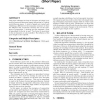Free Online Productivity Tools
i2Speak
i2Symbol
i2OCR
iTex2Img
iWeb2Print
iWeb2Shot
i2Type
iPdf2Split
iPdf2Merge
i2Bopomofo
i2Arabic
i2Style
i2Image
i2PDF
iLatex2Rtf
Sci2ools
ATAL
2008
Springer
2008
Springer
Stable cooperation in changing environments
This paper addresses the issue of emergence of robust cooperation among self-interested agents interacting in N-player social dilemma games. A series of graphs are created each exhibiting a different level of community structure; we show the influence that community structure has on the emergence of cooperation. A strategy set that represent a form of generalised tit-for-tat is used. Two forms of uncertainty in the environment are also modelled. The influence of the game length is also explored. Categories and Subject Descriptors I.2.11 [Distributed Artificial Intelligence]: Multi-agent systems General Terms Experimentation Keywords Cooperation, spatial organisations, uncertainty
ATAL 2008 | Community Structure | Intelligent Agents | N-player Social Dilemma | Robust Cooperation |
| Added | 12 Oct 2010 |
| Updated | 12 Oct 2010 |
| Type | Conference |
| Year | 2008 |
| Where | ATAL |
| Authors | Colm O'Riordan, Humphrey Sorensen |
Comments (0)

